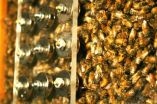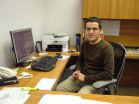(Press-News.org) The protozoan parasite Toxoplasma gondii and the pathogenic bacterium Chlamydia trachomatis exemplify convergent evolution, the development of a similar biological trait in unrelated lineages, according to research presented today at the American Society of Cell Biology's 50th Annual Meeting in Philadelphia.
The biological trait shared by the two pathogens is their modus operandi – how they operate inside human host cells to reproduce themselves, said scientists at the Johns Hopkins Bloomberg School of Public Health, working with researchers at the University of Maryland Dental School and the University of Zurich in Switzerland.
Both T. gondii and Chlamydia hijack their host cells' Golgi apparatus, the "post office of the cell" because it packs up and dispatches cellular cargoes such as lipids in sealed vacuoles. After taking over the Golgi, both pathogens reorganize the organelle into mini-stacks conveniently aligned just outside each invader's hiding place in the cell.
In addition to being an example of convergent evolution, the pathogens' predatory similarity is a possible clue for improving therapies to contain two of the most common infections on earth, said Julia Romano, Ph.D., and Isabelle Coppens, Ph.D.
The research that lead to the discovery of T. gondii and Chlamydia's similar mode of action was prompted by a study on how Toxoplasma secures a nutrient supply inside an infected host. In that National Institutes of Health supported study, scientists noticed a strong parallel with chlamydial infection that had not been suspected since protozoa and bacteria stem from distant evolutionary branches.
Romano and Coppens investigated Toxoplasma-infected host cells to determine how the parasite hijacks lipids named ceramides and found that the protozoan hid from the host's immune system by living inside its own capsule, parasitophorous vacuole (PV). They then determined that the protozoan was able to grab nutrients without exposing itself, because it had located its PV near the hub of the cell's cargo system, the pericentriolar region, and thus close to the Golgi. Within 32 hours of infecting a host cell, the protozoan had sliced the Golgi into fragmented mini-disks and was ingesting intact vacuoles containing ceramides through its PV membrane.
The remodeled Golgi, the PV's location in the pericentriolar region, and the efficient capture of the host's sphingolipid supply reminded the researchers of infection by C. trachomatis, which causes the most frequently reported sexually transmitted disease in the U.S. To test the parallel, the researchers co-infected mammalian cells with T. gondii and C. trachomatis and then observed the two pathogens' quickly dividing the Golgi between them. The two disparate pathogens' distributing the fragments of the organelle equally indicates a common evolutionary strategy.
According to the U.S. Centers for Disease Control (CDC), 1.2 million cases of C. trachomatis infection were reported during 2008 in the U.S. "Silent," untreated C. trachomatis infections can cause infertility in women. Spread by infected meat, Toxoplasmosis is the third leading cause of death attributed to food borne illness.
INFORMATION:
For more information:
ASCB contacts:
Cathy Yarbrough
sciencematter@yahoo.com
858-243-1814 (cell); and 215-418-5306 (Dec. 11-15)
John Fleischman
jfleischman@ascb.org
513-929-4635 (before Dec. 11); and 513-706-0212 (cell)
Julia D. Romano, Ph.D.
Johns Hopkins Bloomberg School of Public Health
(443) 287-1588
jromano@jhsph.edu
Dr. Romano will present, "Co-option of the Host Cell Golgi by the Intracellular Parasite Toxoplasma gondi," Sunday, Dec.12, 2010, 11:30 a.m. to 1 pm. Host-Pathogen Exhibit Halls A/B/C.Abstract: 755. Board B1165
Co-Authors:
J.D. Romano, C. de Beaumont, I. Coppens: Molecular Microbiology and Immunology, Johns Hopkins Bloomberg School of Public Health
S. Sonda:Institute of Parasitology, University of Zurich, Zurich, SWITZERLAND
J.A. Carrasco, P.M. Bavoil: Department of Microbial Pathogenesis, University of Maryland Dental School, Baltimore, MD
Funding:
National Institutes of Health grant R01AI0676
Parasite and bacterium illustrate convergent evolution: Both hijack cells' 'post office'
Research presented at American Society of Cell Biology's 50th annual meeting in Philadelphia
2010-12-14
ELSE PRESS RELEASES FROM THIS DATE:
Cells 'feel' the difference between stiff or soft and thick or thin matrix
2010-12-14
Cultured mesenchymal stem cells can "feel" at least several microns below the surface of an artificial microfilm matrix, gauging the elasticity of the extracellular bedding that is a crucial variable in determining their fate, researchers reported today at the American Society for Cell Biology's 50th Annual Meeting in Philadelphia.
Controlling or predicting how stem cells differentiate into cells of a specific tissue type is a critical issue in the bioengineering of artificial tissue and in stem cell medicine.
To determine how deep a cell's sense of touch can reach, ...
Deleting ghrelin receptor, but not ghrelin, turns up fat-burning thermostat
2010-12-14
Deleting the receptor, not the protein ghrelin itself, turns up the body's fat-burning thermostat, giving aging mice an exothermic boost toward a svelte physique, researchers reported at the American Society of Cell Biology's 50th Annual Meeting in Philadelphia.
The protein's receptor, growth hormone secretagogue receptor (GHS-R), might make a better target than ghrelin for treating obesity, according to Yuxiang Sun, M.D., Ph.D., of the Baylor College of Medicine in Houston, TX.
Sun said that experimentally deleting the receptor from the body cells of laboratory mice ...
Potential chink in armor of African sleeping sickness parasite: It's social
2010-12-14
Long considered a freewheeling loner, the Trypanosoma brucei parasite responsible for African sleeping sickness has revealed a totally unexpected social side, opening a potential chink in the behavioral armor of this and other supposedly solitary human parasites, according to research presented at the American Society for Cell Biology's 50th Annual Meeting in Philadelphia.
"The concept of bacteria acting as groups of cells communicating and cooperating with one another has had a major impact on our understanding of bacterial physiology and pathogenesis, but this paradigm ...
Small details between 'in vivo' and 'in vitro' studies make for big differences
2010-12-14
Small details between "in vivo" and "in vitro" studies make for big differences in understanding diabetes and other secretory dysfunctions
Exocytosis, the fundamental process by which cells secrete hormones such as insulin and other useful biological substances, is regulated far differently in life than in laboratory tissue cultures and explanted organs, according to research presented today at the American Society of Cell Biology's 50th Annual Meeting in Philadelphia.
The unexpected findings that exocytosis regulation "in vivo" is not the same as the process long studied ...
Researchers explain mechanism behind rare muscle disorders
2010-12-14
Researchers have provided the first thorough mechanistic account of how a genetic defect leads to malignant hypothermia (MH) and central core disease (CCD), rare genetic skeletal muscle disorders. The study appears in the January issue of the Journal of General Physiology (www.jgp.org).
Mutations in the type 1 ryanodine receptor (RYR1), the calcium release channel of the sarcoplasmic reticulum (SR) activated during skeletal muscle excitation-contraction (EC) coupling, give rise to CCD. One of the most common CCD-causing mutations is Ile4895Thr. Now, Robert Dirksen (University ...
Many brain tumor patients use homeopathy, alternative treatments
2010-12-14
ST. PAUL, Minn. – Many people with incurable brain tumors use alternative therapies, such as taking vitamins and homeopathy, in addition to their conventional treatments, according to a study published in the December 14, 2010, print issue of Neurology®, the medical journal of the American Academy of Neurology.
About 40 percent of brain tumor patients in the study used alternative therapies including homeopathic remedies, vitamin supplements and psychological therapy.
"The use of these alternative treatments may be largely overlooked and underestimated," said study ...
Increased consumption of folic acid can reduce birth defects but blood levels in Canadians are now high
2010-12-14
Folic acid can reduce birth defects including neural tube defects, congenital heart disease and oral clefts but some speculate high intakes of folic acid may be associated with adverse events such as colorectal cancer, states an article in CMAJ (Canadian Medical Association Journal) (pre-embargo link only) http://www.cmaj.ca/embargo/cmaj100568.pdf.
This study, conducted by researchers at Children's Hospital of Eastern Ontario Research Institute and The Hospital for Sick Children, is the first of its kind in more than three decades, to examine the folate status of Canadians ...
Disease-management programs shown to improve diabetes care
2010-12-14
Disease-management programs, which may include patient education, psychological intervention, dietary education, self-monitoring and telemedicine, can improve diabetes care, states an article in CMAJ (Canadian Medical Association Journal) (pre-embargo link only) http://www.cmaj.ca/embargo/cmaj091786.pdf.
The study, by French researchers, included 41 randomized controlled trials published between 1990 and 2009 with a total of 7013 patients.
The findings showed that disease-management programs are more effective than usual care in reducing glycated hemoglobin levels ...
Sleepless honey bees miscommunicate, too, research at the University of Texas at Austin shows
2010-12-14
VIDEO:
This movie spotlights one waggle dance by a forager that had been sleep-deprived the
previous night. The average dance angle of this dance is superimposed over the dancer and variance around...
Click here for more information.
AUSTIN, Texas—In the busy world of a honey bee hive, worker bees need their rest in order to best communicate the location of food to their hive mates, research from The University of Texas at Austin shows.
"When deprived of sleep, humans ...
Protein restores learning, memory in Alzheimer's mouse model
2010-12-14
SAN ANTONIO, Texas, U.S.A. (Dec. 13, 2010) — Scientists at the UT Health Science Center San Antonio restored learning and memory in an Alzheimer's disease mouse model by increasing a protein called CBP. Salvatore Oddo, Ph.D., of the university's Department of Physiology and Barshop Institute for Longevity and Aging Studies, said this is the first proof that boosting CBP, which triggers the production of other proteins essential to creating memories, can reverse Alzheimer's effects.
The finding, reported this week in Proceedings of the National Academy of Sciences, provides ...
LAST 30 PRESS RELEASES:
Neuroscientists devise formulas to measure multilingualism
New prostate cancer trial seeks to reduce toxicity without sacrificing efficacy
Geometry shapes life
A CRISPR screen reveals many previously unrecognized genes required for brain development and a new neurodevelopmental disorder
Hot flush treatment has anti-breast cancer activity, study finds
Securing AI systems against growing cybersecurity threats
Longest observation of an active solar region
Why nail-biting, procrastination and other self-sabotaging behaviors are rooted in survival instincts
Regional variations in mechanical properties of porcine leptomeninges
Artificial empathy in therapy and healthcare: advancements in interpersonal interaction technologies
Why some brains switch gears more efficiently than others
UVA’s Jundong Li wins ICDM’S 2025 Tao Li Award for data mining, machine learning
UVA’s low-power, high-performance computer power player Mircea Stan earns National Academy of Inventors fellowship
Not playing by the rules: USU researcher explores filamentous algae dynamics in rivers
Do our body clocks influence our risk of dementia?
Anthropologists offer new evidence of bipedalism in long-debated fossil discovery
Safer receipt paper from wood
Dosage-sensitive genes suggest no whole-genome duplications in ancestral angiosperm
First ancient human herpesvirus genomes document their deep history with humans
Why Some Bacteria Survive Antibiotics and How to Stop Them - New study reveals that bacteria can survive antibiotic treatment through two fundamentally different “shutdown modes”
UCLA study links scar healing to dangerous placenta condition
CHANGE-seq-BE finds off-target changes in the genome from base editors
The Journal of Nuclear Medicine Ahead-of-Print Tip Sheet: January 2, 2026
Delayed or absent first dose of measles, mumps, and rubella vaccination
Trends in US preterm birth rates by household income and race and ethnicity
Study identifies potential biomarker linked to progression and brain inflammation in multiple sclerosis
Many mothers in Norway do not show up for postnatal check-ups
Researchers want to find out why quick clay is so unstable
Superradiant spins show teamwork at the quantum scale
Cleveland Clinic Research links tumor bacteria to immunotherapy resistance in head and neck cancer
[Press-News.org] Parasite and bacterium illustrate convergent evolution: Both hijack cells' 'post office'Research presented at American Society of Cell Biology's 50th annual meeting in Philadelphia

